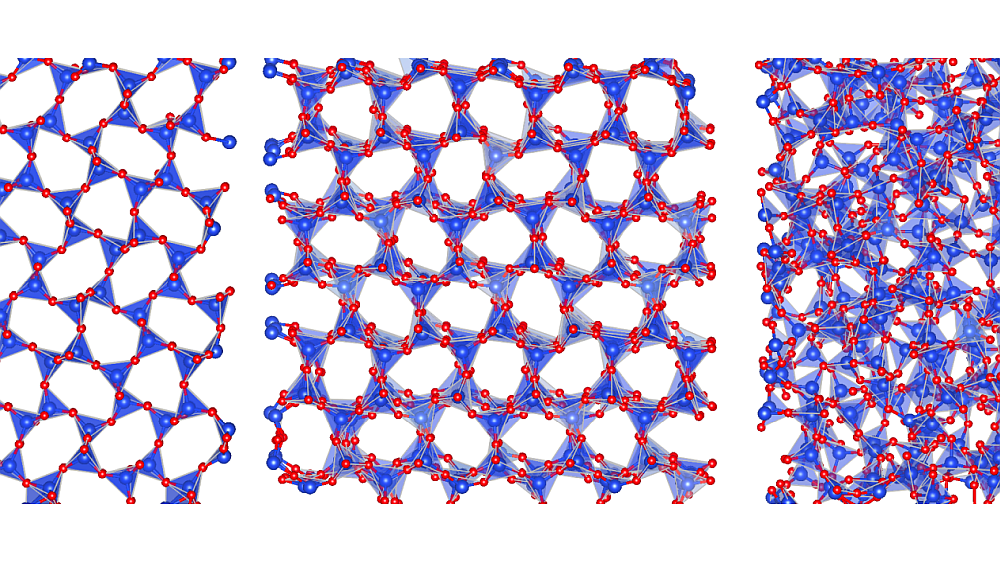
[Image above] An updated ceramic conduction model may help researchers custom-tailor the properties of metal oxides in energy technologies such as lithium-ion batteries, fuel cells, and electrocatalysts. Credit: Robinson et al., Cornell University
Ever since my undergraduate years researching electronic conductivity in the binary tellurium vanadate glass system, I developed a particular fascination for studies that explore how particles move within atomic structures.
I’ve covered several such studies here on CTT, including two studies that describe different models for heat flow in crystals and glass and a study that explores the diffusion mechanism of cations along grain boundaries.
This week when I was reading announcements concerning new materials studies, I came across a recent paper discussing conduction mechanisms in complex oxides. The results from that study are the focus of today’s post.
Small-polaron mobility and the difficulty of describing conduction in complex oxides
When students first learn about electrons and how they move through the atomic structure, professors often describe movement using the band-like conduction mechanism. In this mechanism, electrons are considered delocalized, i.e., not tied to any given location. As such, they can move readily from hole to hole in different energy bands and thus travel throughout the entire material.
However, describing conduction in this way obscures the full scope of atomic interactions going on. In truth, electrons frequently interact with localized vibrations of the atomic lattice called phonons. Movement of electrons is minimally affected when these electron–phonon interactions are weak. But when these interactions are strong, electrons can become coupled to the lattice distortion—forming what is known as a “polaron”—and become localized.
Movement of polarons through a material cannot be described well by the band-like conduction mechanism because the mechanism requires electrons to be delocalized. Instead, a small-polaron transport model developed by Heikes and Ure in the 1960s is used to describe polaron movement.
When Heikes and Ure developed the model, they designed it based on binary compounds, such as spinels of the type M3O4 (M = metal cation). As such, the model considers only two critical steps for charge transport to occur:
- The existence of charge carrier donor/acceptor pairs (or hopping pairs of Mn+/M(n+1)+), and
- The ability to surmount the activation barrier between hopping pairs.
When this model is used to describe conduction in higher-order oxides with multiple cations, it quickly runs into problems, as researchers explain in a recent paper.
“For instance, in the binary spinel Fe3O4, all of the charge-conducting octahedral (Oh) sites are occupied by Fe cations, and charge transport occurs along pathways having an alternating arrangement of Fe2+/Fe3+,” they explain. However, “On replacing an Fe2+ cation with a Mn2+ cation, although the donor/acceptor pair arrangement is still present, the charge transport may be affected by the differences introduced by the hopping barriers or different spinstates between the Fe3+/Mn2+ cation pairs.”
“Additionally, charge transport might only occur between like-cation pairs (i.e., Fe2+/Fe3+ and Mn2+/Mn3+ only), necessitating the separate consideration of donor/acceptor pair concentrations for each species, and for the relative concentrations of these pairs to form conductive pathways,” they add.
The researchers are an interdisciplinary collaboration from Cornell University and Technion–Israel Institute of Technology (Israel). In a Cornell press release, senior author and Cornell associate professor of materials science and engineering Richard Robinson explains why this inability to accurately calculate small-polaron transport in complex oxides is such a big deal.
“…nowadays, metal oxides are used in many applications where the performance is directly impacted by the conductivity—for example, in energy systems like electrical energy storage and generation, electrocatalysis, and in new-generation materials,” Robinson says. “Many people are putting a great amount of experimental effort into oxides right now, but they haven’t carefully examined how the charge carriers move in the material, and how the composition influences that conductivity.”
Fortunately, in recent years, characterization methods to precisely determine cation site-occupation in complex oxides have matured. Such methods open the door for development of a more accurate small-polaron transport model—and that is exactly what the researchers do in the recent study.
Correcting the small-polar transport model by introducing new parameters
To update the conventional small-polaron transport model, the researchers investigated conduction in a tightly defined sample of epitaxial thin films of the spinel MnxFe3−xO4 grown by molecular-beam epitaxy. They chose this material for two reasons:
- They can synthesize the system as a single phase over a wide range of “x” under similar conditions; and
- 3d ternary spinels can have active and inactive cation species at the spinel octahedral sites, which allows the researchers to directly test veracity of the conventional model.
Experiments on the MnxFe3−xO4 spinels confirmed what the researchers suspected—that charge cannot hop between manganese and iron cations. “This creates a requirement for a contiguous elemental path and leads to an additional condition for charge transport to occur: separate, decoupled percolation networks need to be formed by both Fe and Mn cations,” they write.
They also observed a preference for polarons to travel along the manganese pathways rather than the iron pathways, and the presence of asymmetric hopping barriers between cross-hopping pairs. “To account for these observations, we introduce a percolation parameter, a polaron distribution parameter, and a cross-hopping parameter to the conventional electronic conductivity equation that correct the model for higher-order spinels,” they write.
The updated model with these additional parameters showed “excellent overlap” with the experimental trends, thus “confirming the role of percolation pathways and cross-hopping in describing the charge transport in ternary spinels.”
In the press release, Robinson says this updated model will greatly improve the design process of metal oxides. “Instead of the Edisonian, trial-and-error approach of just making and testing a bunch of new materials, we can now take a more systematic approach to figuring out why the materials behave differently, especially on this really important level, which is electronic conductivity,” he says.
The paper, published in Advanced Materials, is “Breakdown of the small-polaron hopping model in higher-order spinels” (DOI: 10.1002/adma.202004490).
Author
Lisa McDonald
CTT Categories
- Modeling & Simulation


